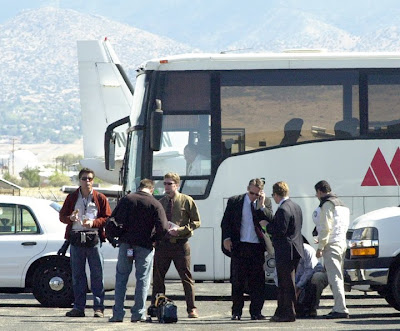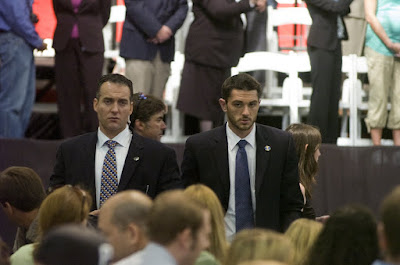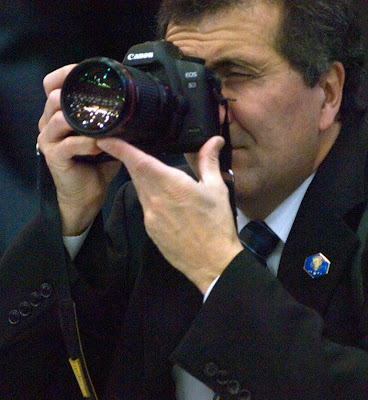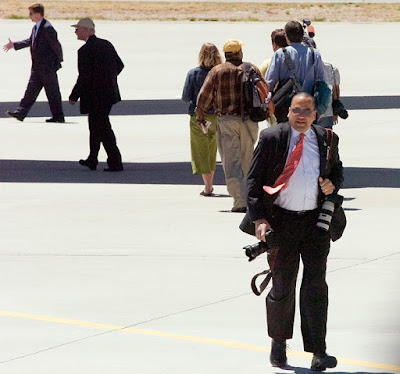What’s Wrong With This Picture?
THE WHITE HOUSE
Office of Media Affairs
________________________________________________
FOR IMMEDIATE RELEASE
September 17, 2010
President Obama to Continue His Conversations with Middle-Class Families Focus on Moving the Economy Forward
WASHINGTON -- Later this month, the President will continue his conversations with middle-class Americans with stops in New Mexico, Iowa, and Virginia. Throughout the summer, President Obama has met with families to listen to their concerns and to discuss specific ways to jumpstart job creation and strengthen the middle class. He met with residents of Fairfax, Virginia, earlier this week, and families in Columbus, Ohio, in August.
During this upcoming trip, the President will continue his focus on moving the economy forward and getting people back to work, while rebuilding a strong economic foundation to ensure future prosperity for all Americans.
The President will participate in events in Albuquerque, New Mexico, on September 28, and Des Moines, Iowa, and Richmond, Virginia, on September 29. More details about the President’s travel, including press credentialing information, will be released in the coming days.
Upon RSVPing The White House Media Affairs Office’s on-line form, it requested as series of pretty standard questions, which have existed from administration to administration; except there was a choice, of what kind of journalism is being practiced. It is a holdover from the 2008 Obama campaign; there was an option for “Blogger Reporter.” I opted for Still Photographer and in the media outlet option wrote Freelance.
The White House Media Affairs Office e-mailed:
The Monday evening arrival and Tuesday afternoon departure of Air Force One in Albuquerque as well as the discussion on the economy will be open to pre-credentialed media. However, space for the discussion is limited. The meeting will be pooled press. The arrival and departure of Air Force One as well as the discussion on the economy are closed to the public.
President Obama’s discussion on the economy, event with the Andy Cavalier family and neighbors in the South Valley was pooled for television, still photography, and print. I did not request credentials for the Tuesday morning event because of the pool protocol. The pool differs a little on the road than it does at the White House; it includes local members of the media.
In D.C., the White House press pool is selected by members of the respective disciplines of the media through the White House Correspondents and the White House Press Photographers Associations.
White House news magazine photo pool was reduced in the past couple of years when U.S. News & World Report and Newsweek withdrew from their arrangement. Television networks alternate in providing coverage for the pool. If there is an opportunity for a one-on-one interview with the president at the local level the local pool TV photographer will provide the images to the other participating stations.
Not permitting pool access won't deter a dedicated and resourceful photographer.
 The Albuquerque Journal’s Jim Thompson, here with Associate Director White House Press Advance Brandon Lepow was the local pool still photographer on Tuesday. Lepow escorted Thompson from the rear of Air Force One after the D.C. pool was loaded onto board. Thompson had ridden with the pool in the motorcade from the day’s earlier events.
The Albuquerque Journal’s Jim Thompson, here with Associate Director White House Press Advance Brandon Lepow was the local pool still photographer on Tuesday. Lepow escorted Thompson from the rear of Air Force One after the D.C. pool was loaded onto board. Thompson had ridden with the pool in the motorcade from the day’s earlier events.
 The Albuquerque Journal’s Jim Thompson, here with Associate Director White House Press Advance Brandon Lepow was the local pool still photographer on Tuesday. Lepow escorted Thompson from the rear of Air Force One after the D.C. pool was loaded onto board. Thompson had ridden with the pool in the motorcade from the day’s earlier events.
The Albuquerque Journal’s Jim Thompson, here with Associate Director White House Press Advance Brandon Lepow was the local pool still photographer on Tuesday. Lepow escorted Thompson from the rear of Air Force One after the D.C. pool was loaded onto board. Thompson had ridden with the pool in the motorcade from the day’s earlier events.
The Journal’s Sean Olsen was the print pool reporter.
Traditionally, the pool is selected by the print writers, radio reporters, television, and still photographers; organized by a local press club or through a coordinated effort. One of the conditions of being the pool photographer is you must share all your work with those who could not attend. Local television stations already have pools in effect, especially to cover Metropolitan Court arraignments.
Pools are also used during campaigns, especially after a front-runner attracts more press coverage and when a nominee is selected.
Republican Presidential nominee Sen. John McCain made a brief stop in Albuquerque on Friday Oct. 3, 2008, to speak at a campaign event at UNM.
 A local press pool was assembled and placed in a holding area to ride in the motorcade.
A local press pool was assembled and placed in a holding area to ride in the motorcade.
 A local press pool was assembled and placed in a holding area to ride in the motorcade.
A local press pool was assembled and placed in a holding area to ride in the motorcade.
The members were:
Albuquerque Journal Photographer, Pat Cunningham,
KOAT TV Photographer J.P. Hyso, with back turned towards camera,
Albuquerque Journal Government / Politics Staff Writer Daniel Boyd, in the brown shirt,
KOAT Reporter Mike Garofalo on the cell phone,
McCain’s Press Advance Matthew Cohen, monitored and accompanied the local press.
The two men on the right are unidentified and may have been van drivers for the motorcade.
As President-elect, Obama spent some vacation time in Hawaii and New Mexico Independent's Matthew Reichbach's look at a December 28, 2008 post by Time magazine's political blogger Mark Halperin, about the sometimes mundane nature of being a member of the press pool.
As much as I would have liked to cover the backyard gathering and the stop at Barelas Coffee House, I would have declined being the pool still photographer, mostly because I would not have been willing to put myself under the deadline, which is required. I have no complaint about Thompson’s selection, but though I got Olsen’s cryptic notes, through the White House Office of Media Affairs, I saw no pictures from Thompson.
The reasoning for making independent photographs is to be an eye witness. I, like every other news outlet, try to bring my viewers the best images and words I can. Those who follow a particular outlet or, hopefully, several outlets, do so for a variety of reasons. The reasoning may include quality of work, tone, and a certain attachment to the style of coverage.
Politics, like many other human endeavors, are a form of theater. People try to put forth their best appearances, be it: attractiveness, fashion, style, manner, eloquence, candor, approachability, friendliness, and other qualities, and characteristics. Intentionally or not; honestly or disingenuously, it's all an act.
Some of us are iconoclasts, we attempt to penetrate the mask worn by our public officials in the public theater. We seek to show those moments, as brief as they may be, that reveal the true nature of the person, Don't read "true nature" as a bad thing, only that it is contrary to the role individuals try to project.
The highest level of political theater is the attempt for politician to appear to be open honest and candid. Those who do it well are probably accepted by the public better and judged on their words and actions rather than any sight of possible manipulation.
The use of "security" for politicians plays a big role in how the public theater is staged.
To my friends in the security business, I am not attacking the importance of or your role in protection, just mentioning the fact security is a reality that represents part of the staging.
 As seen above when President Obama made a May 2009 visit to Rio Rancho High School three years ago, a Secret Service Special Agent, left and Associate Director White House Press Advance Lepow, right, stood at the front of the hall and assessed the crowd just before the formal introduction began.
As seen above when President Obama made a May 2009 visit to Rio Rancho High School three years ago, a Secret Service Special Agent, left and Associate Director White House Press Advance Lepow, right, stood at the front of the hall and assessed the crowd just before the formal introduction began.
In the instant media world of coverage, even the crowd is part of the stage, and they must be ready to play their roles, on cue, and without missing a beat. The use of a shill, someone planted in audiences, during the first year or so in office, followed the campaign tradition, in large crowds, of yelling out, "we love you, Mr. President," to which Obama would respond, "I love you right back." it happens less frequently now.
 However, Chief White House Photographer Pete Souza, the president’s official photographer, has access and his images of such closed events are sometimes provided to the media as handouts.
However, Chief White House Photographer Pete Souza, the president’s official photographer, has access and his images of such closed events are sometimes provided to the media as handouts.
 However, Chief White House Photographer Pete Souza, the president’s official photographer, has access and his images of such closed events are sometimes provided to the media as handouts.
However, Chief White House Photographer Pete Souza, the president’s official photographer, has access and his images of such closed events are sometimes provided to the media as handouts.
Some think this unacceptable in a free society that claims to believe in the principles of a free press.
Associated Press, Reuters, and other news organizations, refuse to put Souza’s images, handed out by the White House Press Office, on their wires citing they are not the result of independent journalism, but official government photos.
 Souza, was a staff photographer for the Chicago Tribune, and assistant professor of photojournalism at Ohio University's School of Visual Communication, before becoming the White House photographer. He supported the NPPA’s stand against accepting handout photos. Souza had also been one of four rotating White House photographers during the Ronald Reagan Administration.
Souza, was a staff photographer for the Chicago Tribune, and assistant professor of photojournalism at Ohio University's School of Visual Communication, before becoming the White House photographer. He supported the NPPA’s stand against accepting handout photos. Souza had also been one of four rotating White House photographers during the Ronald Reagan Administration.
 After President Barack Obama officially announced the killing of Osama Bin Laden on national television, May 1, 2011, he reenacted his walk to the East Room and read the first several paragraphs of his speech for the benefit of the assigned still photo pool.
After President Barack Obama officially announced the killing of Osama Bin Laden on national television, May 1, 2011, he reenacted his walk to the East Room and read the first several paragraphs of his speech for the benefit of the assigned still photo pool.
 Souza, was a staff photographer for the Chicago Tribune, and assistant professor of photojournalism at Ohio University's School of Visual Communication, before becoming the White House photographer. He supported the NPPA’s stand against accepting handout photos. Souza had also been one of four rotating White House photographers during the Ronald Reagan Administration.
Souza, was a staff photographer for the Chicago Tribune, and assistant professor of photojournalism at Ohio University's School of Visual Communication, before becoming the White House photographer. He supported the NPPA’s stand against accepting handout photos. Souza had also been one of four rotating White House photographers during the Ronald Reagan Administration. After President Barack Obama officially announced the killing of Osama Bin Laden on national television, May 1, 2011, he reenacted his walk to the East Room and read the first several paragraphs of his speech for the benefit of the assigned still photo pool.
After President Barack Obama officially announced the killing of Osama Bin Laden on national television, May 1, 2011, he reenacted his walk to the East Room and read the first several paragraphs of his speech for the benefit of the assigned still photo pool.
This was not a new practice, but it wasn't a truth either.
Reuters White House photographer Jason Reed detailed his experience on his Jason's feed, blog posting, "Ready to record history." The other pool photographers were: Associated Press, Pablo Martinez Monsivais, AFP’s Chris Kleponis, The New York Times’ Doug Mills, and freelancer Brendan Smialowski filling the ISP (Independent Still Photographer)'s slot.
The discussion of photographers reenacting the television event exploded, the ethics of the practice of access to the President's events by White House Press photographers was called into question. Poytner Institute's Al Tompkins wrote, Reuters, AP photojournalists describe staging of Obama photo.
It's not a new issue, as observed by, White House: A Chance To Start Over, an editorial by News Photographer Magazine Editor Donald R. Winslow, who also wrote a more recent series of articles on the issue:
White House, Photographers, Agree On New Presidential Pool
 The first White House Photographer Cecil Stoughton, a Captain, then Major in the Army Signal Corps, assigned to the Office of the Naval Aide to the President, became President John Kennedy’s in house photographer; he also served President Lyndon Johnson until 1966.
The first White House Photographer Cecil Stoughton, a Captain, then Major in the Army Signal Corps, assigned to the Office of the Naval Aide to the President, became President John Kennedy’s in house photographer; he also served President Lyndon Johnson until 1966.
 The first White House Photographer Cecil Stoughton, a Captain, then Major in the Army Signal Corps, assigned to the Office of the Naval Aide to the President, became President John Kennedy’s in house photographer; he also served President Lyndon Johnson until 1966.
The first White House Photographer Cecil Stoughton, a Captain, then Major in the Army Signal Corps, assigned to the Office of the Naval Aide to the President, became President John Kennedy’s in house photographer; he also served President Lyndon Johnson until 1966.
Stoughton’s handout photograph of Johnson’s swearing in on Air Force One just hours after Kennedy’s assassination probably was his signature piece.
Stoughton also had a run-in with President Richard Nixon at the January 20, 1973, second inaugural. Stoughton was working as chief photographer at the National Parks Service and went to the inauguration to photograph the swearing in.
A secret service agent told him to move, so he did. He went down the main aisle knelt down and took his picture; only problem was he was wearing a bright blue and orange plaid jacket and he was in the background of Ollie Atkins’ “official photograph.”
It’s not the first time that photographers of presidential inaugurations had distractions in the background of their pictures.

 Listed as the first civilian “official” White House Photographer, is Yoichi R. Okamoto who served President Johnson from 1966.
Listed as the first civilian “official” White House Photographer, is Yoichi R. Okamoto who served President Johnson from 1966.
Ollie Atkins served as personal photographer to President Richard Nixon and Chief of the White House Photographic Staff;
 David Hume Kennerly served President Gerald Ford, Kennerly gave a talk at the 2000 annual National Press Photographers Association's conference in San Francisco. about winning the 1972 Pulitzer Prize for feature photography for his coverage of the Vietnam War for United Press International;
David Hume Kennerly served President Gerald Ford, Kennerly gave a talk at the 2000 annual National Press Photographers Association's conference in San Francisco. about winning the 1972 Pulitzer Prize for feature photography for his coverage of the Vietnam War for United Press International;
President Jimmy Carter had no official White House photographer;
 current Chief White House Photographer Pete Souza also served during Ronald Reagan’s second term, as part of a four photographer rotation;
current Chief White House Photographer Pete Souza also served during Ronald Reagan’s second term, as part of a four photographer rotation;
David Valdez served Vice President, then President George H.W. Bush;
Robert McNeely was Director of White House Photography serving President Bill Clinton for five and a half years and was replaced by Sharon Farmer; and
 Eric Draper served as Special Assistant to the President and White House Photo Director for George W. Bush. Draper had unlimited access to Bush; every meeting, every phone call, was photographed. He is seen above during a Bush political visit to Albuquerque, his hometown, in 2008.
Eric Draper served as Special Assistant to the President and White House Photo Director for George W. Bush. Draper had unlimited access to Bush; every meeting, every phone call, was photographed. He is seen above during a Bush political visit to Albuquerque, his hometown, in 2008. Souza, is a very good photojournalist, with what photographers call having a “good eye.”
Souza, is a very good photojournalist, with what photographers call having a “good eye.”
However, the issue is not about Souza or the quality of his work; it is about the attitude of an administration claiming to be more transparent than any before in not allowing a free press to view, show and report upon what they independently observe.
NOTE:
The above tightly cropped photograph of Souza appears to be out of focus due to a combination of slight subject movement and more camera shake. The time was 6:55 pm and sunset was 6:57 pm, which means most of the sun was already below the horizon. The president’s party was in the shadow of a hanger and it was getting dark.
This picture was taken with the camera on a mono-pod using a Reflex-Nikkor 500mm f/8 at a 1/15 second.
Yet, upon close inspection you will note that Souza’s eye is in sharp focus, the result of one of the White House photo pool using a flash at the very moment my shutter was open. It becomes one of my personal series, “sharing the light.”
Though it would appear that the combination of long lens, small aperture, slow shutter speeds, would make this a near impossible shot, it wasn’t, as this accompanying picture shows, taken just a minute later 6:56 pm, at a 1/20 second.
There is a trust issue that a photojournalist does not grant their subjects; if a president has an incident, like Ford stumbling down an airplane stairway, or hitting a spectator with his golf ball during celebrity-pro golf game, or H.W. Bush throwing up on the Japanese Prime Minister, or George W. Bush crashing or falling from his bicycle on slippery pavement, injuring a Scottish police constable, an official photograph is unlikely to be made available. A photojournalist’s coverage may be published as news, in reporting on the continued health of the presidents or their injuring people through their actions.

I was granted trust and access when I did a “fly on the wall” photo essay in 1973, of then rookie U.S. Senator Pete Domenici. It wasn’t total access, and he was concerned when I photographed him with a drink in his hand, because constituents on the east side of the state did not know he drank. I told him I didn’t know if he was drinking liquor or ice water and if his constituents found out, then they found out. Until now I never revealed that this had been an issue for Domenici. I have it on good authority, from one who was closely involved in east side Republican politics that Domenici regularly drank with his major campaign contributors. It clearly wasn’t an issue for his east side constituents as he was reelected five more times by substantial margins.
Despite not being able to gain access to closed GOP caucus meetings or the 1973 secret briefing from National Security Adviser Henry Kissinger on the Vietnam War, Domenici made himself and his family available to my photography.

 Souza shadows the president as Assistant Deputy of the White House Photo Office Chuck Kennedy, above and below, shadows Souza.
Souza shadows the president as Assistant Deputy of the White House Photo Office Chuck Kennedy, above and below, shadows Souza.
 Kennedy's role, is wingman to Souza. While Souza is in close, Kennedy opts for different angles, as he did here during President Obama's visit to Rio Rancho High School. Kennedy photographed from a balcony where no one else was allowed by the Secret Service.
Kennedy's role, is wingman to Souza. While Souza is in close, Kennedy opts for different angles, as he did here during President Obama's visit to Rio Rancho High School. Kennedy photographed from a balcony where no one else was allowed by the Secret Service.
Despite not being able to gain access to closed GOP caucus meetings or the 1973 secret briefing from National Security Adviser Henry Kissinger on the Vietnam War, Domenici made himself and his family available to my photography.

 Souza shadows the president as Assistant Deputy of the White House Photo Office Chuck Kennedy, above and below, shadows Souza.
Souza shadows the president as Assistant Deputy of the White House Photo Office Chuck Kennedy, above and below, shadows Souza.
Kennedy may be best known for his 2009 inaugural photo the Obama family during the swearing in taken for the McClatchy/Tribune family of newspapers.
 I received two messages from the White House Media Affairs Office (combined):
I received two messages from the White House Media Affairs Office (combined):
 I received two messages from the White House Media Affairs Office (combined):
I received two messages from the White House Media Affairs Office (combined):RSVP CONFIRMATION: Air Force One Arrival (and Departure):
Thanks for your RSVP to the Arrival (and Departure) of Air Force One in Albuquerque, New Mexico. The names your outlet submitted for credentials have been confirmed. Be sure to bring a government issued photo ID for entry and note the times below you must be on site for access.
Though I am not eligible to be a member of the White House News Photographers Association, because one has to live within 40 miles of the White House, I support their code of ethics.
In WHNPA’s Constitution Article III Codes of Ethics (Revised 2005) preamble statement of ethics:
The White House News Photographers Association, a professional organization dedicated to the support of photojournalism and to ensure the rights of its members in the performance of their duties, strongly believes in the public's natural and legal right to freedom in searching for the truth and the right to be accurately and completely informed about the world in which we live. We believe that there is a direct linkage between the survival of a democratic society and an accurate and free press. To that end, we believe that the public journal is a public trust and that all connected with it are to the full measure of their responsibility trustees for the public. We believe that motion and still pictures are an indispensable means of informing people about their world. We strongly urge and expect our members to maintain the highest standards of ethical conduct in serving the public interest. To that end, all WHNPA members must aspire to the following code of ethics:
Click to read the eight points of ethics that apply well beyond White House news photographers, applying equally to other photographers and journalists of all media. I also support the codes of ethics of two organizations to which I do belong: the Society of Professional Journalists, and the National Press Photographers Association.
Part One: Republican Party gubernatorial candidate Susana Martinez’ June 10, 2010 visit to Conspiracy Brews, Martinez August 11, 2010, Education Reform Press conference
Part 12 September 26, 2010, Congregation Albert gubernatorial debate
No comments:
Post a Comment